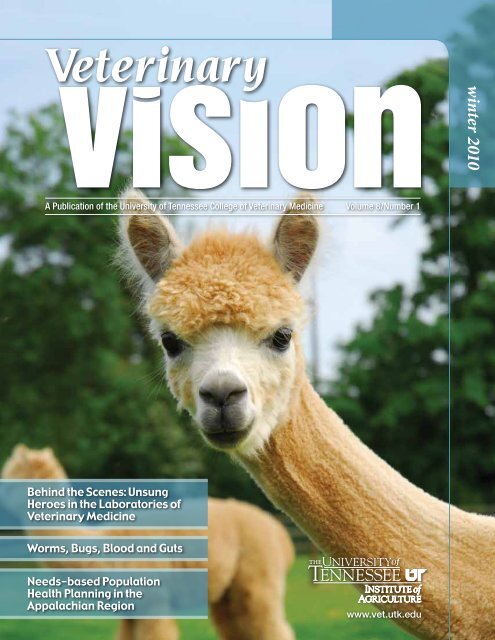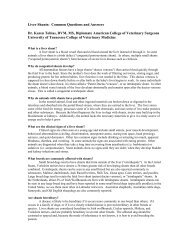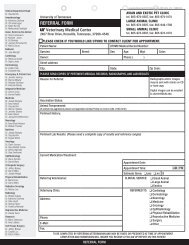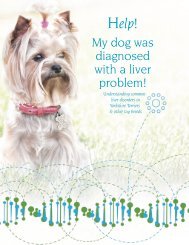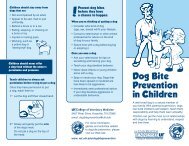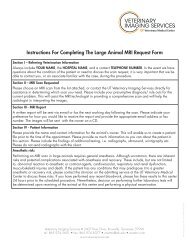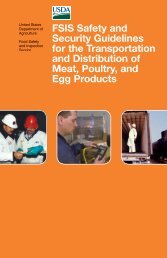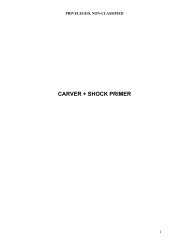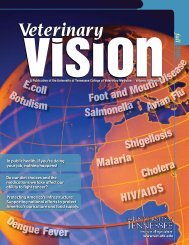w inter 2010 - The University of Tennessee College of Veterinary ...
w inter 2010 - The University of Tennessee College of Veterinary ...
w inter 2010 - The University of Tennessee College of Veterinary ...
- No tags were found...
Create successful ePaper yourself
Turn your PDF publications into a flip-book with our unique Google optimized e-Paper software.
Left: Dr. Robert Donnell oversees the Anatomic Pathology laboratory, which includes necropsy (post-mortem) and biopsy (surgical pathologies). <strong>The</strong> labperforms post-mortem examinations and tests biopsy samples from UTCVM and referral veterinarians. Right: <strong>The</strong> endocrinology laboratory deals withthe study <strong>of</strong> glands and hormones and their related disorders. Under the direction <strong>of</strong> Dr. Jack Oliver, it has gained an <strong>inter</strong>national reputation in adrenalabnormalities and is the college’s busiest diagnostic lab.Labs: Unsung Heroes Behind the ScenesWhen a client visits the large or small animalhospitals at the <strong>University</strong> <strong>of</strong> <strong>Tennessee</strong> <strong>College</strong><strong>of</strong> <strong>Veterinary</strong> Medicine, the client service representatives,students, veterinary technicians and clinicians are the onesthe client <strong>inter</strong>acts with. But clients rarely get a chanceto meet the unsung heroes behind the scenes: the peoplerunning the diagnostic laboratories. Good medicinedemands good diagnostic work.Of the college’s eight diagnostic laboratories, six arehoused within the Department <strong>of</strong> Comparative Medicine:bacteriology/mycology, endocrinology, immunology,parasitology, pharmacology and virology. Clinical Pathologyand Anatomic Pathology (which includes necropsyand biopsy) are in the Department <strong>of</strong> Pathobiology.Combined, the labs run diagnostics on more than 100,000samples submitted each year.<strong>The</strong> labs’ primary function is to support the smallanimal and large animal clinics. <strong>The</strong>y are essential fordiagnosing medical problems and helping to monitorinfectious disease outbreaks. In addition to providingtraining sites for graduate students and direct learningexperiences for veterinary student research, the labs alsoserve the veterinary community at large, receiving samplesfor diagnosis from the region, country and world. <strong>The</strong>college’s diagnostic laboratories fully integrate teaching,service and research.Left: Dr. Sherry Cox leads the pharmacology laboratory, where the effects <strong>of</strong> drugs and other chemicals on animals’ biological systems are studied.Right: Dr. David Bemis oversees the bacteriology/mycology laboratory where bacteria and fungi and their <strong>inter</strong>actions with their host animals are studied.4<strong>Veterinary</strong> vision • w<strong>inter</strong> <strong>2010</strong>
A Host <strong>of</strong> Parasites:“Worms, Bugs, Blood and Guts”Nematode. Ascarid. Coccidia. No, those are notnames middle school students use to taunt eachother. <strong>The</strong>y are parasites, creatures that live <strong>of</strong>f their hosts,and Dr. Sharon Patton has dedicated her entire pr<strong>of</strong>essionalcareer studying the likes <strong>of</strong> them.Parasites occur in just about all animal groups, and theparasitology lab at the UT <strong>College</strong> <strong>of</strong> <strong>Veterinary</strong> Medicinereceives samples from all across the country. Patton, apr<strong>of</strong>essor in the Department <strong>of</strong> Comparative Medicine,promises to one day write a book called “Worms, Bugs,Blood and Guts.” Until then, she verbally warns students<strong>of</strong> hookworms—those voracious bloodsuckers—and advisesstudents to treat feces with respect, since it containsmany clues to an animal’s health.Diagnosing and monitoring parasites are importantto both pet and human health. While the CompanionAnimal Parasite Council says gastrointestinal parasitesinfect almost 34 percent <strong>of</strong> the dogs in the United States,and the American Heartworm Society says heartwormsinfect more than 240,000 dogs and 3,100 cats, some <strong>of</strong> theparasites are zoonotic, meaning they can pass from animalto human and vice versa.Some <strong>of</strong> the parasites can have dire circumstances forhumans. Baylisascaris, or raccoon roundworm, is foundin raccoon feces, and can travel through the liver, brainor spinal cord. Yet another reason NOT to feed raccoonsaround your home. Toxoplasma gondii is a parasite <strong>of</strong> catsthat also infects other animals including people. Only catspass the infective stages in their feces, but other animalsmay have the parasite in their muscles and organs afterthey eat the infective stages. <strong>The</strong> Centers for Disease Controland Prevention estimates that more than 22 percent<strong>of</strong> the population 12 years and older in the United Stateshave been infected with Toxoplasma. <strong>The</strong> disease, toxoplasmosis,is usually not a serious disease in people or cats,although both may develop muscle pain, flu-like illnessand lymphadenopathy. Serious illness may occur in thosewith weakened immune systems, and severe consequencesincluding birth defects, blindness and brain damage may6<strong>Veterinary</strong> vision • w<strong>inter</strong> <strong>2010</strong>
occur in babies born to a mother infected while pregnant.Women who are infected during pregnancy are also at risk<strong>of</strong> miscarriage. People become infected by eating the parasitein raw or undercooked meat, mussels and oysters, orby accidentally eating soil contaminated with Toxoplasma“eggs” on unwashed hands, fruits or vegetables.Children may become infected with the commonroundworm (called ascarids or Toxocara spp) <strong>of</strong> dogs andcats, although these worms cannot mature in a person’sintestine. <strong>The</strong> adult ascarids live in the small intestine <strong>of</strong>the dog or cat and pass eggs in the feces. <strong>The</strong> ascarid eggsdevelop in the soil and in about four weeks a larval wormis in the eggs. Dogs and cats are infected when they eatthese larvated eggs. When another vertebrate animal (thatincludes people), eats these larvated eggs, the larvae hatchin the intestine, go into the bloodstream and migrate intothe muscles, liver, lungs and other organs. Dogs and catscan also be infected by eating the mature larvae in thetissues <strong>of</strong> these animals. <strong>The</strong> worms cannot mature toadults in these animals. If children eat the larvated eggsin contaminated soil, the larvae will migrate into theirmuscles and eyes and produce disease. Each year morethan 700 people infected with Toxocara spp experiencepermanent or partial loss <strong>of</strong> vision.Last fall, the UTCVM hosted the national meeting<strong>of</strong> the American Society <strong>of</strong> Parasitology in Knoxville.Patton, a former president <strong>of</strong> the society, and Dr. CharlesFaulkner, a clinical assistant pr<strong>of</strong>essor, were charged withironing out the details: program presenters, properlycooked food, and clean, parasite-free bathrooms. Pattonsays more than 250 people from around the worldgathered to share recent scientific discoveries and remaincurrent on parasites. “<strong>The</strong> meeting included veterinaryparasitology, human parasitology, physiology, ecologyand life-cycle studies <strong>of</strong> parasites, as well as diagnosis,treatment and control. Basically, it included everythingyou ever wanted to know about parasites … and more!”Patton says each year the meeting brings people togetherwho may be working on the same problem from differentangles. “Who knows what you really need to know?” shesays. “I might think I know a particular parasite insideand out, until I meet someone who is studying it on themolecular level. That stimulates new thought processesand moves science forward.”the MuffinMysteryBy Karl Snyder, seniormedical technologistII, UTCVM ClinicalPathology LabIt was a day like any other whenthe phone rang, and a lady beganpleading, “I hope you can help me, sir.I’ve been calling all over the city trying t<strong>of</strong>ind someone who can check something to seeif has rodent droppings on it.” She had my attention.I began to turn the problem over in my mind as she told her story. “Iwas eating a breakfast muffin that I’d gotten from a restaurant. I wasabout half finished when I put on my glasses. I was horrified to find acouple <strong>of</strong> little black things stuck to the box and sitting on top <strong>of</strong> mymuffin. I called the Health Department and they are going to inspectthe restaurant but they wanted me to have the material examined tosee what it is.”I had considered several things by this point and <strong>of</strong>fered thefollowing: “<strong>The</strong> only thing we might be able to do is smear it on aslide and stain it. If we see a lot <strong>of</strong> bacteria that would be about theonly explanation. However, all we could say is ‘it is probably this’ or‘possibly that.’ We couldn’t pin down anything that would hold up incourt.” She assured me that she just wanted to know if she should gosee a doctor.Within an hour she was standing in the lab holding the suspectmuffin in its original container. She pointed to the mysterious contaminants.Katie, our trusty lab assistant, smeared a sample on a slidewhile I pressed some <strong>of</strong> the brown material on the glucose pad <strong>of</strong> aurine stick and added a drop <strong>of</strong> water, getting a very strong positive.I needed more pro<strong>of</strong> before signing <strong>of</strong>f on this case. Lugol’s Iodinerevealed starch; Sudan IV stain lit up the fat globules and I wassurprised to see cholesterol crystals in the confection. “Chocolate,ma’am. Nothing but chocolate.” She looked relieved, perhaps alittle embarrassed, and was grateful for our help. “Pleased to be <strong>of</strong>assistance,” I said. “This is a full service lab.”Dr. Sharon Patton (at left with students) is past president <strong>of</strong>the American Society <strong>of</strong> Parasitologists and the SoutheasternSociety <strong>of</strong> Parasitologists (SSP), a past member <strong>of</strong> the ExecutiveCommittee <strong>of</strong> the Council <strong>of</strong> Scientific Society Presidents,the Secretary-Treasurer <strong>of</strong> SSP, a member <strong>of</strong> the board <strong>of</strong> theCompanion Animal Parasite Council, and a contributor to severalother scientific societies including the American Association<strong>of</strong> <strong>Veterinary</strong> Parasitologists.Patton’s research <strong>inter</strong>ests include diagnostic parasitology,zoonotic parasites (particularly toxoplasmosis), heartworms indogs and cats, and parasite-induced diseases <strong>of</strong> farm, companionand exotic animals. She is author or co-author <strong>of</strong> morethan 100 scientific papers and has presented more than 150scientific and service talks.<strong>Veterinary</strong> vision • w<strong>inter</strong> <strong>2010</strong> 7
Undergraduates in the LabIn his second year <strong>of</strong> college, Stephen Kania walkedinto a research laboratory where a friend was workingand said, “This is it. This is what I’m going to do the rest<strong>of</strong> my life. This fits.” Kania, now an associate pr<strong>of</strong>essor inthe UTCVM Department <strong>of</strong> Comparative Medicine, wenton to earn a bachelor’s degree in biology, a master’s inveterinary microbiology and a PhD in veterinary infectiousdiseases.Kania splits his time evenly between teaching, researchand diagnostics. Outside <strong>of</strong> the classroom, he carries outthese activities in the immunology laboratory. Much <strong>of</strong> thework in the lab involves molecular diagnostics, moleculargenetics and molecular characterizations. “In terms <strong>of</strong> thecollege one <strong>of</strong> our missions is to study infectious diseases,”says Kania. <strong>The</strong> college’s Center <strong>of</strong> Excellence in LivestockDiseases and Human Health funds some <strong>of</strong> the infectiousdiseases research done in his lab. Kania says studyinginfectious diseases is important to both human and animalhealth. Methicillin resistance, a hot topic in human andveterinary medicine, arose in the organisms that infecthumans long before being found in ones that infectanimals. To Kania, that is one <strong>of</strong> the more <strong>inter</strong>esting andbest reasons to study methicillin-resistant Staphylococcuspseud<strong>inter</strong>medius in dogs. “Fifteen years ago, you couldn’tfind one <strong>of</strong> these organisms resistant to methicillin; nowwe’re seeing about 30 percent resistance. On a graph,that’s a quick climb, and we’re very <strong>inter</strong>ested in learninghow resistance genes are spread to susceptible organismsand conditions that favor the proliferation <strong>of</strong> resistantorganisms.” Kania’s lab is studying it locally, nationally andcollaborating with researchers in Europe. <strong>The</strong> researchteam at the UTCVM includes clinicians, microbiologists,technologists, veterinary students and graduate students.Dr. Linda Frank focuses on transmission between ownersand their pets and Dr. David Bemis leads an effort tocharacterize resistance to multiple classes <strong>of</strong> antibiotics.Bemis works closely with Kania in teaching undergraduatesthe ins and outs <strong>of</strong> research.A few years ago, Kania decided to add an undergraduateteaching component when the UT Knoxville McNairSummer Research Institute sent out a call for laboratorieswilling to participate in a graduate school preparatory<strong>inter</strong>nship. “I had no ideawhat it would be like tohave an undergrad workin the lab.” Kania says.“When Edward Oforicame he didn’t know whatto expect either. He notonly worked in the lab thatyear, but the next summer,too, doing PCR analysisresulting in several publications.He’s a real brightguy who helped train some <strong>of</strong> our veterinary students whowere doing research projects in the lab.” When it was timefor Ofori to graduate (he’s currently pursuing a PhD inbiomedical engineering), Kania laughingly asked, “Well,are there any more <strong>of</strong> you?”Kania believes taking courses where students arehanded reagent A and reagent B to mix together to seewhat happens is vastly different than actually getting involvedin a lab on a daily basis, thinking about a researchproject and using initiative.In fact, initiative is usually the way he finds students.“<strong>The</strong> way I select them is I choose from the ones wh<strong>of</strong>ind me,” he explains. “<strong>The</strong>y are going out and contactingpotential researcher mentors, and perhaps they arecontacting 100 researchers. <strong>The</strong>y are saying ‘I want toget research exposure,’ and I think that’s a good indicator<strong>of</strong> their commitment.” That’s what Edward Ofori’syounger brother Michael did. During his undergraduatestudies in pre-med, he spent his summers working in theimmunology lab. Three other students, Caroline C<strong>of</strong>er,Lauren Liatt and Laura Eberlein, worked in the lab asundergraduates before being accepted to UTCVM. Eachyear, as the students’ skills progress beyond routine tasks,Kania produces more challenging projects. Eberlein, class<strong>of</strong> 2011, has sequenced the entire 27,000 bp cassette thatcontains the genes responsible for methicillin resistance inS. pseud<strong>inter</strong>medius.Many undergraduates have limited opportunities tobe involved in a meaningful way with research and havefour years to determine if that career choice is right forthem. Although it is a big investment <strong>of</strong> time, Kania enjoysencouraging people who show an <strong>inter</strong>est in research.“<strong>The</strong> students bring a lot <strong>of</strong> enthusiasm into the labs.<strong>The</strong>y <strong>of</strong>ten come in not knowing which end <strong>of</strong> a pipette tosqueeze,” Kania laughs. “It takes a while before they canmake a large contribution, but for the most part these arevery talented individuals, quick learners. <strong>The</strong>y ask lots andlots <strong>of</strong> questions and it’s a joy to answer those questions.”Kania says teaching is the bottom line. “My greatestreward is being able to contribute to students’ education.That’s what it’s all about as far as I’m concerned.”8<strong>Veterinary</strong> vision • w<strong>inter</strong> <strong>2010</strong>
Take 2 Aspirin, Buy Stockin Tissues, and Call Me inthe MorningNever one to turn up her nose at a good medical mystery, Dr. Melissa Kennedy and her lab have helpedidentify herpes virus in Asian elephants, were the first to publish that equine herpes could affectgazelles, and were the first to diagnose influenza in giant anteaters, a species listed as near endangered; that’snothing to sneeze at.Kennedy, a veterinarian and clinical virologist with a PhD in Comparative and Experimental Medicine andan associate pr<strong>of</strong>essor at the college, received a call from Nashville Zoo veterinarian Dr. Sally N<strong>of</strong>s who wasconcerned about a 12-member colony <strong>of</strong> giant anteaters, a near threatened species. An outbreak <strong>of</strong> respiratorydisease had swept through the colony, affecting all 11 adults. <strong>The</strong>y suffered severe nasal discharge andcongestion, poor appetite and lethargy. Kennedy’s lab needed samples for testing. Nasal samples. From thegiant anteaters.<strong>The</strong> virology lab at the veterinary college utilizes an electron microscope, a vital piece <strong>of</strong> expensiveequipment usually only found in academic and research institutions used to identify unknown viruses. Sinceperforming diagnostic work for exotic species is not a moneymaker, not many commercial laboratories areequipped to do it. Kennedy says it’s part <strong>of</strong> the responsibility <strong>of</strong> a land-grant institution. “We service communitieslocally, regionally, nationally and <strong>inter</strong>nationally helping them with infectious disease problems.Otherwise, they might not have anyone else to turn to for assistance.”Once the samples from the giant anteaters reached the lab, the hunt was on and history was made. Afterisolating the virus from the samples, extensive testing with the electron microscope as well as genetic sequencingshowed the anteaters were infected with a human influenza virus.<strong>The</strong> flu. Kennedy says the impact on civilization is minimal, but it shows howadaptable the wily virus is. “Just when you think you’ve got them figured out,they’ll do something different.”Kennedy admits she harbors a healthy respect for viruses. “I think they areway cool, but I’m weird,” she laughs and then explains they are the ultimatesurvivors that become intimately involved in the cells they target. “Virusesdon’t set out to kill their host because they are so dependent upon the cell.<strong>The</strong>y’re opportunistic and design ways to elude the host’s defense systemsand use the cell to their advantage. It’s amazing.” Kennedy says all they’rereally trying to do is survive and reproduce their own.But in giant anteater populations, the influenza virus will have to tryto survive without the help <strong>of</strong> humans. As word <strong>of</strong> the discovery spreads,management <strong>of</strong> giant anteaters is changing. “Given the contagious nature <strong>of</strong>the influenza virus, caretakers with respiratory disease should be restrictedfrom caring for giant anteaters.” And it all started with a runny nose.Photo courtesy <strong>of</strong> Pete Meenen<strong>Veterinary</strong> vision • w<strong>inter</strong> <strong>2010</strong> 9
Needs-basedPopulationHealth Planning:Identifying Barriers toHealth Care Services inthe Appalachian Region<strong>of</strong> East <strong>Tennessee</strong>About Dr. Agricola OdoiDr. Agricola Odoi is an assistant pr<strong>of</strong>essor <strong>of</strong> epidemiology inthe Department <strong>of</strong> Comparative Medicine at the <strong>University</strong><strong>of</strong> <strong>Tennessee</strong> <strong>College</strong> <strong>of</strong> <strong>Veterinary</strong> Medicine, and an adjunctfaculty member in the <strong>College</strong> <strong>of</strong> Public and Allied Health atEast <strong>Tennessee</strong> State <strong>University</strong>. He is an analytical epidemiologistwith research experience in Uganda, Kenya, Canada and theUnited States. His research <strong>inter</strong>ests include the application <strong>of</strong>geographic information systems and spatial epidemiology methodsin the investigation <strong>of</strong> animal and human diseases, zoonoticinfections <strong>of</strong> public health significance, and determinants <strong>of</strong>population health. He teaches both pr<strong>of</strong>essional and graduatelevelepidemiology courses at UTCVM.Odoi is also involved in the National Institute for Mathematicaland Biological Synthesis (NIMBioS), a new center based at<strong>University</strong> <strong>of</strong> <strong>Tennessee</strong> and aimed at fostering collaborations oncutting-edge research activities between biology and mathematicsresearchers from across the globe. As part <strong>of</strong> the institute’sactivities, Odoi and colleagues from Colorado State <strong>University</strong>and the USDA organized an investigative workshop this summerwith the goal <strong>of</strong> developing new tools to better understandand help with addressing the problem <strong>of</strong> tuberculosis in cattlein the U.S. Last summer, Odoi also worked with a group <strong>of</strong>undergraduate and veterinary students from other universitiesacross the U.S. as part <strong>of</strong> the NIMBioS’ Research Experience forUndergraduate and <strong>Veterinary</strong> Students (REU/REV), a programintended to introduce veterinary as well as undergraduate mathand biology majors to research while working together as a team.Outside <strong>of</strong> work, Odoi enjoys spending time with his dear wife,Evah, their two lovely children, Faithful and Livia, and is activelyinvolved in church activities. Odoi is originally from Ugandawhere he had his veterinary training at Makerere <strong>University</strong>,Kampala. He completed his graduate training in epidemiology atthe <strong>University</strong> <strong>of</strong> Nairobi (Kenya) and the <strong>University</strong> <strong>of</strong> Guelph(Ontario, Canada). After completing his PhD at the <strong>University</strong> <strong>of</strong>Guelph, Odoi worked in public health in Canada before joiningthe UTCVM Department <strong>of</strong> Comparative Medicine. He loves thesouthern weather, countryside and people.By Dr. Agricola Odoi, assistant pr<strong>of</strong>essor <strong>of</strong> epidemiology,Department <strong>of</strong> Comparative MedicineWhen someone suffers from a heart attack orstroke, receiving urgent care is critical. But forpatients in <strong>Tennessee</strong>’s rural Appalachian communities,can they get to that treatment in time? Dr. Agricola Odoiis answering that question, thanks in part to a two-yearresearch grant from the Greater Southeast Affiliate <strong>of</strong> theAmerican Heart Association. Odoi’s study, “IdentifyingNeighborhoods Lacking Timely Access to Heart andStroke Care in the East <strong>Tennessee</strong> Appalachian Region,”will investigate issues related to access to emergency strokeand heart attack medical care.“People living in neighborhoods lacking timely accessto emergency treatments for these conditions may bedisadvantaged,” says Odoi. “<strong>The</strong>refore, one <strong>of</strong> the aims<strong>of</strong> the study is to identify communities that, even if anambulance responded in record time to a 911 call, thedriving times to the nearest specialty hospital are too longfor a stroke or heart attack patient to arrive at the hospitalwithin the time recommended by the American HeartAssociation so as to avoid complications or even death.”<strong>The</strong> study is part <strong>of</strong> a larger research effort intended toperform health equity analyses in communities in <strong>Tennessee</strong>with the long-term goal <strong>of</strong> identifying barriers to accessand utilization <strong>of</strong> health care services. <strong>The</strong> results will beused to guide needs-based population health planning.Stroke and heart attack are serious problems in theUnited States, costing the country $65.5 billion and$156.4 billion annually, respectively. Stroke is the thirdmost common cause <strong>of</strong> death and the leading cause <strong>of</strong>adult disability in the country. Heart attacks account forapproximately 450,000 deaths in the U.S. every year. <strong>The</strong>burdens <strong>of</strong> these conditions in the U.S. vary by geographicallocation, with the highest risks being reported in thesoutheastern states. Compared to other states, <strong>Tennessee</strong>has the third- and fourth-highest risk <strong>of</strong> death from heart10<strong>Veterinary</strong> vision • w<strong>inter</strong> <strong>2010</strong>
Thank you to Abbott Animal Health, Merial Animal Healthand Pfizer Animal Health for their sponsorship <strong>of</strong> the 2009Anesthesia Crew!<strong>The</strong> Anesthesia Crew is an extraordinarily successful educational program at UTCVM.Launched in 2004, and initially funded in part by Pfizer Animal Health, the program providesas many as 10 <strong>of</strong> the very best preclinical veterinary students with an early experience <strong>of</strong> theclinical environment in the anesthesia service in the Small Animal Hospital. As members <strong>of</strong>the crew, these competitively selected students spend the summer between their second andthird years <strong>of</strong> veterinary college enhancing their pr<strong>of</strong>essional development while contributingto the college’s clinical mission. “<strong>The</strong>se students act as key members <strong>of</strong> our clinical anesthesiaand pain management team working on individual clinical anesthesia patients,” says Dr. RalphHarvey, DVM, MS, DACVA, associate pr<strong>of</strong>essor and Anesthesia Crew chief. “We insure thesestudents are exposed to a beneficial learning environment, made richer by opportunities toparticipate in a range <strong>of</strong> activities, including emergency and critical care cases.”In the introductory five years <strong>of</strong> the Anesthesia Crew, the mutual support, teamwork and sharing<strong>of</strong> knowledge among crew members and fourth-year clinical students have been impressive.Harvey continues, “Although unexpected, these well may be the most widespread and beneficialoutcomes <strong>of</strong> bringing these preclinical students into the hospital—we’ve broken down barriersin the curriculum and enriched the educational experience for all.”academic & hospital services update<strong>Veterinary</strong> vision • w<strong>inter</strong> <strong>2010</strong> 13
2008-2009 Faculty AwardsUT’s Alliance<strong>of</strong> WomenPhilanthropistspresentedone <strong>of</strong> its four2009 GivingCircle GrantAwards to Dr.Lilith (Charmi)Mendes-Handagama,ComparativeMedicine, in the amount <strong>of</strong>$18,000 for her project, “DevelopingNon-surgical Pet Contraceptives.”<strong>The</strong> winner <strong>of</strong>the 2009 Carl J.Norden-PfizerDistinguishedTeacher Awardwas Dr. RobertHenry, pr<strong>of</strong>essor,ComparativeMedicine.<strong>The</strong> 2009 Student Chapter <strong>of</strong> theAmerican <strong>Veterinary</strong> Medical Association(SCAVMA) OutstandingEducator <strong>of</strong> the Year was Dr. Michael(Mickey) Sims, ComparativeMedicine.Dr. India Lane, Small Animal ClinicalSciences and director, EducationalEnhancement for UTCVM, receivedthe Helen B. Watson OutstandingDissertation in the UT <strong>College</strong> <strong>of</strong>Education, Health and HumanSciences. She also received UT’sOutstanding Faculty Award for herwork advising a student’s doctoraldissertation.Dr. Angela Lusby, DVM ‘04, CEMPhD ‘09, Dipl. ACVN, received thePhi Zeta Excellencein <strong>Veterinary</strong>Clinical ResearchAward at 2009UT Comparativeand ExperimentalMedicine ResearchSymposium. Lusby is the firstUTCVM small animal resident tocomplete the UT Standard NutritionProgram, and is now a diplomate <strong>of</strong>the American <strong>College</strong> <strong>of</strong> <strong>Veterinary</strong>Nutrition. She is also the recipient<strong>of</strong> a Waltham Travel Grant andpresented her work at the European<strong>College</strong> <strong>of</strong> <strong>Veterinary</strong> InternalMedicine Congress, held in Portugalin September.Dr. Joseph (Joe) Bartges, DVM,PhD, Dipl. ACVIM and ACVM,pr<strong>of</strong>essor <strong>of</strong>medicineand nutrition,SmallAnimalClinicalSciences,received the B. Ray Thompson Sr.Outstanding Faculty Award at the2009 UT Institute <strong>of</strong> AgricultureAwards Day. Bartges holds the AcreeFamily Endowed Chair in SmallAnimal Research.Dr. David Hicks, resident, SmallAnimal Clinical Sciences, receivedthe first endowed Mark BloombergMemorial Research Award for hiswork on gait analysis at the 2009<strong>Veterinary</strong> Orthopedic SocietyConference. Hicks is a PhD studentin the Comparative and ExperimentalMedicine graduate program atUTCVM.Small Animal Medicine <strong>inter</strong>n Dr.Courtney Kleinhelter was the 2009recipient <strong>of</strong> the Jessie’s Memorial“Top Doc” Intern Award. <strong>The</strong> awardis provided annually by Mr. JayRobinson and Ms. Brenda Perry inmemory <strong>of</strong> their beloved Yorkie,Jessie.<strong>The</strong> 2009 BrandyMemorial Awardwas presented toUTCVM cardiologistDr. BeckyGompf, SmallAnimal Clinical Sciences, at the 2009UTCVM Honors and Awards Convocation.<strong>The</strong> annual award is madepossible by Mr. Sherman “Jerry” andMrs. Diane Garrett in memory <strong>of</strong>their beloved dog, Brandy.Adjunct assistant pr<strong>of</strong>essor inComparative Medicine, Dr. JohnDunn, DVM, PhD, was honoredby the Centers for Disease Controland Prevention with the 2008 JamesH. Steele <strong>Veterinary</strong> Public HealthAward.Drs. Margo Holland, Steve Kania,David Bemis and H. C. (Robert)Wang, all <strong>of</strong> Comparative Medicine,received <strong>University</strong> <strong>of</strong> <strong>Tennessee</strong>Center <strong>of</strong> Excellence awards inresearch.Pathobiology resident Dr. MarciaIlha received the Young InvestigatorPoster Award for original research atthe annual meeting <strong>of</strong> American <strong>College</strong><strong>of</strong> <strong>Veterinary</strong> Pathologists. Ilhaalso received a student scholarshipfrom the C. L. Davis Foundation.Dr. Donald McGavin’s lifetimecontributions to pathology wererecognized with the Farrell LectureshipAward, also sponsored by the C.L. Davis Foundation. McGavin is apr<strong>of</strong>essor emeritus in Pathobiology.In MemoriamDr. Robert (Bob) Selcer, former pr<strong>of</strong>essor<strong>of</strong> neurology in the Department<strong>of</strong> Small Animal Clinical Sciences,died June 13, 2009. Selcer was boardcertified by the American <strong>College</strong> <strong>of</strong><strong>Veterinary</strong> Internal Medicine (neurology)and was on the UTCVM facultyfrom 1977 until 2003. He completedthe DVM at Texas A&M <strong>University</strong>and before joining UTCVM, he servedon the faculty at the <strong>University</strong> <strong>of</strong> California.Following his retirement fromUT, he remained in the Knoxville area.Selcer is survived by his wife, Peggy,and children Michael and Katie.faculty focus<strong>Veterinary</strong> vision • w<strong>inter</strong> <strong>2010</strong> 17
faculty focusDr. Sherry Cox, ComparativeMedicine, and Dr. Marcy Souza,Small Animal Clinical Sciences, arerecipients <strong>of</strong> $50,500 in funding fromthe Morris Animal Foundation fortheir work in collaboration with the<strong>University</strong> <strong>of</strong> Wisconsin School <strong>of</strong><strong>Veterinary</strong> Medicine to investigatetramadol, a pain medication, inAmazon parrots. Dr. Cheryl Greenacre,Small Animal Clinical Sciences,has also received funding from theMorris Animal Foundation for herwork evaluating blood levels <strong>of</strong> painrelievingdrugs in reptiles (beardeddragons).Dr. Beth Hamper, Small AnimalClinical Sciences, received a grantfrom the Winn Feline Foundationto evaluate ways <strong>of</strong> improving felineimmune function through diet. Shewill be working with CVM’s nutritionfaculty members, Drs. Claudia Kirkand Joe Bartges.Dr. Melissa Kennedy, DVM ’83,PhD ’91, Dipl. ACVM, ComparativeMedicine, was recently elected as amember <strong>of</strong> the board <strong>of</strong> directors,Winn Feline Foundation.Dr. Mohammed Reza Seddighi,who recently completed his residencyin anesthesia at UTCVM, has beenappointed as a clinical assistantpr<strong>of</strong>essor in anesthesia, a positionshared by both the large and smallanimal hospitals.Dr. Patricia Sura, Small AnimalClinical Sciences, was honored atthe American <strong>College</strong> <strong>of</strong> <strong>Veterinary</strong>Surgeons’ last meeting with theaward for best clinical publicationin the journal <strong>Veterinary</strong> Surgery.Her article entitled “Comparison<strong>of</strong> 99mTcO4-trans-splenic portalscintigraphy with per-rectal portalscintigraphy for diagnosis <strong>of</strong> portosystmeicshunts in dogs,” was coauthoredby Drs. Karen M. Tobias,Frederica Morandi, Greg B. Danieland Rita L. Echandi.Dr. Tomas Martin-Jimenez,Comparative Medicine, launchedUTCVM’s new Clinical PharmacologyConsultation Service in May.He and two graduate students, Drs.Nicolas Villarino and Tamara Veiga,provide consultation to the college’sclinicians, residents and <strong>inter</strong>ns.Faculty Hires, Promotions,Tenure, Transfers andRetirementsDr. Sherry K. Cox, promoted toclinical associate pr<strong>of</strong>essor, ComparativeMedicine.Dr. Christine G. Egger, pr<strong>of</strong>essorwith tenure, Small Animal ClinicalSciences.Dr. Michael M. Fry, promoted toassociate pr<strong>of</strong>essor with tenure,Pathobiology.Dr. Cheryl B. Greenacre, pr<strong>of</strong>essor,Small Animal Clinical Sciences.Dr. Tomas Martin-Jimenez,promoted to associate pr<strong>of</strong>essor,Comparative Medicine.Dr. Elizabeth Strand, promoted toclinical associate pr<strong>of</strong>essor.Dr. William B. Thomas, promotedto pr<strong>of</strong>essor, Small Animal ClinicalSciences.Dr. David “Dave” Edwards, pr<strong>of</strong>essoremeritus and former departmenthead, Pathobiology.Dr. Maria Cekanova, transfer fromPathobiology to Small AnimalClinical Sciences.Dr. Donna M. Raditic,visiting scholar, Nutritionand IntegrativeMedicine Service,Small Animal ClinicalSciences.Dr. Susannah Lillis,clinical assistant pr<strong>of</strong>essor, Radiology,Small Animal Clinical Sciences.Dr. Malanie J. Perrier, clinicalassistant pr<strong>of</strong>essor, Surgery, LargeAnimal Clinical Sciences.Dr. Jill Narak, assistant pr<strong>of</strong>essor,Neurology, Small Animal ClinicalSciences.Dr. Angela Lusby, clinical instructor,Nutrition, Small Animal ClinicalSciences.Dr. Kristie Steuer, clinical instructor,Field Services, Large Animal ClinicalSciences.Dr. Beth Miller Johnson, clinicalassistant pr<strong>of</strong>essor, Community Practice,Small Animal Clinical Sciences.New DiplomatesDr. Teresa Buchheit, LACS, ACVIMDr. Karen Kalck, DVM, DACVIM–Large Animal, LACSResidents and InternsDeparting House Officers whohave completed their <strong>inter</strong>nship orresidency requirements at UTCVMare listed below.ResidentsDr. Matthew C. Allender, ZoologicalDr. David A. Hicks, SurgeryDr. Scott A. Rizzo, MedicineDr. Mohammad Reza Seddighi,Anesthesia, clinical assistant pr<strong>of</strong>essor,UTCVMDr. Christina M. Wolf, Neurology18<strong>Veterinary</strong> vision • w<strong>inter</strong> <strong>2010</strong>
InternsDr. Sara J. Almon, private practiceDr. Menolly R. Beittenmiller,private practiceDr. Glen A. Bonin Jr., surgical<strong>inter</strong>nshipDr. Javier Gallegos, private practiceDr. Brian A. Maran, cardiologyresidencyDr. Courtney P. Kleinhelter, privatepracticeStaff NewsNelle Wyatt, LVMT, is the newly appointedreferralcoordinator forthe veterinaryteaching hospital.She handles bothsmall and largeanimal referralsfrom communityveterinarians.Members<strong>of</strong> the college’s talented InstructionalResources staff receivedfive distinguished awards at theBioCommunications AssociationConference held in July in Utah. <strong>The</strong>BCA is an <strong>inter</strong>national pr<strong>of</strong>essionalorganization <strong>of</strong> people working inthe biological communications field.Photographer Greg Hirshoren wona Citation <strong>of</strong> Merit in the Portraitdivision. Videographer BabbetHarbison won a Citation <strong>of</strong> Merit forDog Bite Prevention in the GraphicsMedia: Specialty category; her entryalso won a BCA Medical EducationAward. Photographer Phil Snow wona Citation <strong>of</strong> Merit in the Clinicaldivision and an Award <strong>of</strong> Excellencein the Specimen division. Graphicdesigner Anik Vasington alsoworked on the project. You can seetheir work at http://bca.org/gallery/index.html.Virginia “Ginny” Bleazey, administrativespecialist, Pathobiology,received the E. G. Chapman OutstandingService Award at 2009 UTInstitute <strong>of</strong> Agriculture Awards Day.New StaffersTammy Berry, grants and contractscoordinator, Research AdministrationPei Wang, research specialist I/technologist, Comparative MedicineDavid Boruff, IT specialist I/CVMwebmasterStaff PromotionsRupal Brahmbhatt, ComparativeMedicine, to laboratory technologistII (senior lab assistant)Staff KudosToni Conatser and Kim Abney,Comparative Medicine, earned theirEnvironmental Health and Safetycertificates for successfully completingLaboratory Hazardous WasteManagement Training.Staff RetirementsJan Grady, LACS, Senior BudgetClerkMarilyn B. Cottrell, ComparativeMedicine, senior laboratory technologistI (research specialist)Interns Completing the <strong>Veterinary</strong>Technician Internship Program atUTCVMHeather GearJennifer NichiporukKayla RegerTalisha Soto<strong>The</strong> <strong>College</strong> is proud to recognize the accomplishments and contributions <strong>of</strong>the CVM Outstanding Employee for Fall 2009, Michele Wilson. Michele'sCVM career began in 2003, and she is now a Licensed <strong>Veterinary</strong> TechnicianLevel II and works on the Oncology Service in the Department <strong>of</strong> SmallAnimal Clinical Sciences.<strong>The</strong> <strong>College</strong> <strong>of</strong> <strong>Veterinary</strong> Medicines (CVM)Outstanding Employee Award recognizesexemplary performance, dedication, commitmentand compassion <strong>of</strong> a college employeetwice yearly. Nominations are considered bythe college's Awards Committee, made up <strong>of</strong>representatives from throughout the college.Her co-workers call Michele an irreplaceablemember <strong>of</strong> the Oncology Service and describeher as knowledgeable, committed and pr<strong>of</strong>essional.Michele is lauded for consistently puttingthe well-being and <strong>inter</strong>ests <strong>of</strong> her patientsand clients before anything else, many timesstaying past the usual 8-5 workday to assistwith sick patients. In developing an amazingrapport with clients, her caring nature becomes apparent. Students alsoappreciate Michele's supportive, positive and helpful attitude as she teachesthem the skills considered important on their oncology rotation.In receiving the award, Michele (in typical Michele fashion) said theOutstanding Employee Award was for all her fellow technicians who workside-by-side in the hospital.faculty focus<strong>Veterinary</strong> vision • w<strong>inter</strong> <strong>2010</strong> 19
alumni and developmentPegasus HelpsPay it ForwardCompany Gives Wings toCorporate ResponsibilityAngel was at death’s door. Her gums were black andlegs were cold. After her veterinarian in Middle<strong>Tennessee</strong> resuscitated Angel, owners Jeff Ray and NancyYonko had the 2-year-old <strong>Tennessee</strong> Walking Horserushed to the large animal hospital at UTCVM whereshe was diagnosed with colitis (an infection <strong>of</strong> the largecolon which erodes the organ’s lining) and life-threateningendotoxemia. She was even showing signs <strong>of</strong> laminitis.Dr. Steve Adair, associate pr<strong>of</strong>essor <strong>of</strong> equine surgery,decided to try an aggressive form <strong>of</strong> treatment and use hyperbaricoxygen therapy (HBOT) on Angel. With HBOT,the patient is placed in a chamber that delivers pressurizedoxygen, and while there wasn’t any published data onHBOT use with horses, the experimental therapy had beenshown to speed up the process <strong>of</strong> regenerating the lining<strong>of</strong> the colon. UTCVM is the only veterinary college inthe country with an on-site HBOT chamber. <strong>The</strong> ownerswere ready for any option. “Not everyone is meant to ownan animal,” Ray says. “But if you are, then you have theresponsibility and obligation to take the best care possible<strong>of</strong> that animal. In doing so, you have to be willing to allowthe doctors to gain additional knowledge through tryingnew therapies and techniques.” Ray says exploring optionsand learning from the experience allows the veterinariansto treat the next horse more effectively and efficiently. Thatis part <strong>of</strong> their passion. “That process moves the collegeforward in doing what it’s supposed to do—educate, doresearch and push science to the next level.”High levels <strong>of</strong> oxygen get into the bloodstream andimprove circulation, enhancing the healing process. Aweek and 10 HBOT treatments later, Angel was showingdramatic improvement and soon went home, but onemonth later, she developed abscesses in her front hooves.It was back to Knoxville for treatment where Adair hadto remove the entire front wall <strong>of</strong> her ho<strong>of</strong>. Within fourmonths, Angel had grown a whole new ho<strong>of</strong> wall. Fouryears later, she’s in “fashion clogs” (i.e., Steward Clogs) anda spunky member <strong>of</strong> the family.In addition to taking animal ownership seriously, Ray,owner <strong>of</strong> Pegasus Paper Products and a UTCVM advisoryboard member, is passionate about corporate responsibility.Pegasus Paper Products, created in 2007, is an onlinecompany that sells high quality equestrian-themed giftwraps, bags and accessories. <strong>The</strong> company’s philosophyis pay it forward. For each item sold, a portion <strong>of</strong> theproceeds benefits the UT <strong>College</strong> <strong>of</strong> <strong>Veterinary</strong> Medicineand HBOT. “People are tired <strong>of</strong> bailouts and handouts,but they don’t mind spending money if they know theirmoney is going to support a good cause.” Ray believes thatbusinesses become great through philanthropy and beingactive civic-minded members in the community. “Manypeople ahead <strong>of</strong> us helped get the college where it is today,and many more in the next generations will come alongbehind us. That’s how good things get done.” Ray believesmaintaining a strong college <strong>of</strong> veterinary medicine isessential to <strong>Tennessee</strong>’s agricultural industry. “We can’tafford not to have a strong veterinary college from a foodsafety standpoint, from a large animal care standpoint, andfrom a small animal care standpoint. We have an obligationto make this college successful as residents <strong>of</strong> <strong>Tennessee</strong>and as animal owners.”After Angel’s illnesses and before birthing Pegasus Paper Products, Jeff Ray and NancyYonko worked tirelessly with the horse industry to raise funds for a new HBOT unit. <strong>The</strong>new unit has been in place since 2007 and many horses have been treated. Ray says he’stouched anytime he sees a horse being treated in the HBOT unit. One horse, in particular,stands out: Pattycake. Third-degree burns covered almost 60 percent <strong>of</strong> her body, from herneck to her tail, following a barn fire. It was the worst burn case Dr. Adair had ever seen,and he wasn’t sure she would survive. In addition to antibiotics and skin grafts, HBOTwas part <strong>of</strong> her healing process. Ray, who doesn’t know her owners, says he feels proudwhen he sees Pattycake or hears about her magnificent progress. “I get to see how thediscoveries made with Angel and the new HBOT unit helped Pattycake. We’re tiny fish,but when a whole bunch <strong>of</strong> us work together, we create a big school.”20<strong>Veterinary</strong> vision • w<strong>inter</strong> <strong>2010</strong>
Alumni AwardsDr. David “Hank” Wright, ’88, <strong>of</strong> Collierville, <strong>Tennessee</strong>,received the 2008 <strong>Tennessee</strong> <strong>Veterinary</strong> Medical Association’sOutstanding Practitioner Award for his commitmentto providing exceptional treatment, unselfishly giving <strong>of</strong>his time and service to his clients and the community, andelevating the standards <strong>of</strong> veterinary practice. Wright is apartner in the Collierville Pet Hospital.<strong>The</strong> 2008 UTCVM Distinguished AlumniAward WinnersPrivate Practice AwardDr. Corey Miller, ’94, co-founding partner, Equine MedicalCenter, Ocala, FloridaFirst Decade <strong>of</strong> Achievement AwardDr. Kristi Lively, ’99, co-owner, Village <strong>Veterinary</strong> andLaser Center, Farragut, <strong>Tennessee</strong>Non-private Practice AwardDr. Teri Rowles, ’80, national coordinator, protectedresources, Marine Mammal and Sea Turtle Division <strong>of</strong> theNational Marine Fisheries Service (NOAA)theAnnualDonorHonor Roll <strong>of</strong> Givingwww.vet.utk.edu/giving<strong>The</strong> Annual Donor Honor Roll <strong>of</strong> Giving for thegift period <strong>of</strong> July 1, 2008 through June 30, 2009is now available on UTCVM’s Web site atwww.vet.utk.edu/giving.Thank you for your continued support for the<strong>College</strong> <strong>of</strong> <strong>Veterinary</strong> Medicine!alumni and developmentThank you for your <strong>inter</strong>est inPegasus Paper Products! We’dlike to <strong>of</strong>fer you a 25% savingson your entire order when youshop at our secure web site,www.pegasuspaper.comPlease enter code UT25 for eachitem during the checkout process.We appreciate your <strong>inter</strong>est andyour business.<strong>Veterinary</strong> vision • w<strong>inter</strong> <strong>2010</strong> 21
alumni and developmentPhoto courtesy <strong>of</strong> Bovine Veterinarian Magazine<strong>Tennessee</strong> Taps UTCVM Alumfor State VetAdd state veterinarian to the many jobs Dr. CharlesHatcher has tackled. <strong>Tennessee</strong> Department <strong>of</strong>Agriculture (TDA) Commissioner Ken Givens announcedHatcher’s promotion in May. In a TDA news release,Givens said, “We’re excited to have Dr. Hatcher step intothis new role as state veterinarian. His knowledge andexperience will be a continued asset to the agency.” <strong>The</strong>state veterinarian is charged with protecting and monitoringanimal health.After graduating from the UT <strong>College</strong> <strong>of</strong> <strong>Veterinary</strong>Medicine in 1984, Hatcher worked in private practice inKentucky 10 years before returning to his family farm in<strong>College</strong> Grove, <strong>Tennessee</strong>, to establish a mixed animalpractice and reopen the dairy with his family. Hatcher,whose areas <strong>of</strong> expertise include dairy and beef productionmedicine, reproduction and nutrition, has alsoserved as president <strong>of</strong> the American Association <strong>of</strong> BovinePractitioners.Hatcher has worked for more than fiveyears as TDA staff veterinarian and wasresponsible for the state’s livestock premisesregistration program, disease monitoringactivities for sheep and cattle, and alsosupervised the statewide team <strong>of</strong> animalhealth technicians.As state veterinarian, Hatcher is responsiblefor certification and enforcement<strong>of</strong> animal health standards required for<strong>inter</strong>state and <strong>inter</strong>national commerce <strong>of</strong>livestock and livestock products. He alsoworks with federal animal health <strong>of</strong>ficials inaccrediting <strong>Tennessee</strong>’s approximately 1,000practicing private veterinarians.Hatcher says animal health is closelytied to public health and vital to the state’sagricultural economy. “I look forward toworking with producers and our partners tocontinue the level <strong>of</strong> animal health serviceand protection that <strong>Tennessee</strong> is known for,”said Hatcher. “I’m pleased to work with adedicated team <strong>of</strong> animal health pr<strong>of</strong>essionals,including assistant state veterinarianPhilip Gordon, who tirelessly serves thecitizens <strong>of</strong> <strong>Tennessee</strong> each day.”Hatcher succeeds Dr. Ron Wilson, whopassed away last year. During his 25 yearswith TDA—more than eight <strong>of</strong> them as stateveterinarian—Wilson was instrumental inhelping to expand animal disease diagnosticservices statewide.Hatcher says filling Wilson’s shoes willbe a difficult task. “He was an exceptionalveterinarian and served the state for manyyears, and I hope to build upon his legacy.”Information from the <strong>Tennessee</strong> Department<strong>of</strong> Agriculture22<strong>Veterinary</strong> vision • w<strong>inter</strong> <strong>2010</strong>Dr. Charles Hatcher (CVM ‘84) was recently named<strong>Tennessee</strong> State Veterinarian. He’s pictured with hisdaughter Jennifer (CVM ‘05) on the Hatcher family farm.
Knox County First-GradeStudents Receive New‘Rufus’ DVDUTCVM continued its program to prevent dog bites lastspring with the help <strong>of</strong> new materials and an old friend.Rufus, the lovable canine-costumed star <strong>of</strong> the college’sdog bite prevention campaign, is the star <strong>of</strong> a new awardwinningvideo, brochure and bookmark. Knox Countyfirst-graders—all 4,750 <strong>of</strong> them—received the educationalmaterials during the 2009 Dog Bite Prevention Week (May17-23).volunteer spiritIn the new DVD, Rufus, the lovable, canine-costumedstar, clearly teaches children not to attempt to hug a dogto show affection. <strong>The</strong> video and corresponding materialsreplaced annual classes for children held at the college.A special news conference at Inskip Elementary Schoolkicked <strong>of</strong>f the DVD distribution. <strong>The</strong> event featured Rufusand a Human-Animal Bond in <strong>Tennessee</strong> (HABIT) volunteerdog to reinforce the lessons on the video. Along withthe DVD, a survey was provided for parents and guardiansto complete. Comments on the completed surveys werevery encouraging, and parents said without exception howmuch they appreciated the training the DVD provided.With this DVD distribution, the program’s total number <strong>of</strong>contacts, including brochures and bookmarks, increasedto more than 10,000. This figure does not include another5,000 visits to the Dog Bite Prevention Program’s Web siteor teachers’ packets delivered to 160 elementary schoolteachers in Union, Loudon and Claiborne counties. <strong>The</strong>program continues to spotlight Rufus at the college’sR espect U nderstanding F riendly U nfriendly Stay awayannual spring open house, and HABIT volunteers conductdog bite prevention classes for children in public schoolsand other venues in Knox and surrounding counties.UTCVM has won several awards for the program, includinga BioCommunications Association Citation <strong>of</strong> Meritin both the Medical Education Specialty Category andGraphics Media. <strong>The</strong> DVD won the college a Silver Daveyin the Fifth Annual International Davey Awards for 2009.Financial support for the Knox County DVD distributionwas provided by local plastic surgeon Dr. Tom Gallaherand PetSafe Village.Knox County ranked third in the state in the number <strong>of</strong>outpatient dog bites in 2007 with a total <strong>of</strong> 497 incidents,a decrease from 541 bites in 2006. But the program aimsto reduce the number more dramatically with this neweducational approach. Experts say that education can helpprevent most dog bites, and UTCVM Pr<strong>of</strong>essor MichaelSims says that “first-graders can easily absorb the messagespresented in the DVD.”UTCVM’s goal is to distribute DVDs to all first-gradeteachers across <strong>Tennessee</strong>. <strong>The</strong> DVD contains all <strong>of</strong> thematerials that teachers need to present the total programto their classes. Additionally, these teachers will be able toshare their DVDs with other elementary teachers, parentsand friends in their communities.<strong>The</strong> UTCVM Dog Bite Prevention Program depends ondonations to continue reaching children with this importantinformation and training. For more information,please go to www.vet.utk.edu/dogbiteprevention andwww.vet.utk.edu/giving.<strong>Veterinary</strong> vision • w<strong>inter</strong> <strong>2010</strong> 23
It’s all about Litter ControlRemote Area Medical comes to LincolnMemorial <strong>University</strong>Pet overpopulation touches every community, whetheror not it can afford it. This past summer, CAIT teamedwith Lincoln Memorial <strong>University</strong> (LMU) and RemoteArea Medical (RAM) to provide free veterinary care at aRAM expedition in Harrogate, <strong>Tennessee</strong>. Eight veterinarystudents, two college staff members and four CAITmembers volunteered their weekend to help spay/neuterand vaccinate 268 pets at the clinic. “<strong>The</strong>se students gaveup a summer weekend to join volunteers from around thecountry to help this community and its animals. <strong>The</strong> ownerswere courteous and thankful for the opportunity toreceive basic veterinary care for their pets. It’s easy to say,‘a spay or neuter only costs X amount <strong>of</strong> dollars,’ but forsome people, that X amount is groceries for the week.” Jenningssays RAM events are eye-openers for many students.<strong>Tennessee</strong> Animal Care and Control ConferenceFor the second time in as many years, CAIT partneredwith the Animal Control Association <strong>of</strong> <strong>Tennessee</strong>(ACAT) and the <strong>Tennessee</strong> Humane Association (THA) tohold the <strong>Tennessee</strong> Animal Care and Control Conferenceat the Embassy Suites Hotel in Franklin, <strong>Tennessee</strong>. Morethan 100 attendees ranging from animal control <strong>of</strong>ficers,humane investigators, animal care staff, shelter managersand executive directors, to veterinarians and technicianshelped to make last year’s conference a huge success.Jennings says the conference helps create a strong supportnetwork among those working with animals. “<strong>The</strong>se folksare important in every community across the state; manyplay a role in public health as well as reuniting familiesand their pets.” <strong>The</strong> in-state conference allows agencies toparticipate in affordable training opportunities.New Laws for Animals in <strong>Tennessee</strong>Recently, two laws were passed by the <strong>Tennessee</strong> legislaturethat will <strong>inter</strong>est pet owners across the state. One newlaw authorizes municipalitieshaving a population <strong>of</strong>at least 100,000 (Chattanooga,Clarksville, Knoxville,Memphis and Nashville) toestablish an ordinance thatwill allow the presence <strong>of</strong>a patron’s companion doginto outdoor dining areas <strong>of</strong>a restaurant, if the ordinanceprovides for adequatecontrols to ensure compliancewith the <strong>Tennessee</strong>Food, Drug, and CosmeticAct and any other applicablestatutes and ordinances.Another law, the CommercialBreeder’s Law, pertainsto those who sell cats and dogs in <strong>Tennessee</strong>. While therules and regulations are still being written for this newlaw, it took effect in January 2009 and will aid animalcontrol <strong>of</strong>ficers and state inspectors in shutting downpuppy mills in the state.<strong>The</strong> CAIT Spay & Neuter HelplineCall 1-866-907-SPAY (7729) to learn if there are any spayand neuter opportunities in your community. <strong>The</strong> helplineitself and the part-time worker hired to answer the phoneare funded by PetSafe Village.volunteer spiritFor more information on any projects described above,please visit the CAIT Web site at www.vet.utk.edu/cait, ore-mail Teresa Jennings, CAIT Program Administrator, atCAIT@utk.edu.<strong>Veterinary</strong> vision • w<strong>inter</strong> <strong>2010</strong> 25
volunteer spiritHABIT VolunteersRemember Our Veteransby Karen J. Armsey, program coordinatorAt the UT <strong>College</strong> <strong>of</strong> <strong>Veterinary</strong> Medicine, the WarDog Memorial stands watch outside the frontentrance to remind us not only <strong>of</strong> the special servicescanine companions performed in combat, but also <strong>of</strong> thespecial connection between people and dogs. Human-Animal Bond in <strong>Tennessee</strong> (HABIT) volunteers have beenusing that bond to brighten the lives <strong>of</strong> veterans and otherresidents at the Ben Atchley State Veteran’s Home sinceit opened in early 2007 in the Hardin Valley Road area <strong>of</strong>Knox County.As a new HABIT program coordinator, I joined GaryGreenwald, an Air Force veteran, and his HABIT dogLilly back in June to visit the 140-bed facility as part <strong>of</strong> myorientation process. Walking the halls with Gary and thechocolate Labrador retriever, I heard residents’ stories andsaw their smiles as Lilly worked her quiet magic. At eachstop, Gary would tell me the resident’s career accomplishmentswhile Lilly made her visit. Gary instructed Lillyto “visit,” and she would place her muzzle on the knee orbedside <strong>of</strong> the resident, making herself available to handsmade frail by age and illness.One <strong>of</strong> the first gentlemen we met played football for the<strong>University</strong> <strong>of</strong> <strong>Tennessee</strong> and went on to play pr<strong>of</strong>essionally.He is still a big man, but he no longer speaks or moves freely.However, he does smile with recognition when Lilly entershis room. It was obvious that she was going to bless everyoneshe met in the facility with her gentleness and affection.In memory <strong>of</strong> HABIT volunteer cat, Smudge…As we entered the day room on the Alzheimer’s unit,several gentlemen turned their heads to watch Lilly, andsome were able to call out to Gary and Lilly to visit them.Gary chatted with each man in turn while Lilly nuzzledhands and smiled into their faces. Lilly visited throughoutthe room, and even shared some <strong>of</strong> her joy with the staff.Clearly, it wasn’t just the residents who looked forward toHABIT visits: several staff persons knelt to get their “furryfix” and a moment <strong>of</strong> stress relief, too.Lilly has some lady friends at the Ben Atchley StateVeteran’s Home, too. We made a point to stop by MissReethra’s room because she really loves to see Lilly. MissReethra is a tiny little lady whose face broke into a hugesmile when Lilly came to her bedside. <strong>The</strong>re was no doubtthat this visit was a good thing.Another one <strong>of</strong> Lilly’s special stops was to see Loula. Loulais blind and deaf; she spends her day curled up in her bedwith very limited movement and <strong>inter</strong>action with others.When Loula realized that Lilly was under her hand, shebecame animated, and spoke to and petted Lilly. Gary saysthat Loula always thanks him for bringing Lilly, and it’seasy to see why.While we were walking through the halls, a visitor askedus to be sure to visit her parents, who are both residentsat the facility. Bill and Gracie share a room and arealways happy to see Lilly. In this little picture <strong>of</strong> shareddomesticity, all that was missing for them was a dog. Sowhen HABIT volunteers visit their room, they are pictureperfect and all smiles. A sense <strong>of</strong> normalcy is another one<strong>of</strong> the gifts a HABIT dog can bring to a residential facilitythat seems more hospital, sometimes, than home.After we finished making the rounds, Gary shared withme that Lilly has a special friend who waits in his motorizedchair at the front door. Though James doesn’t go outanymore, he has a friend bring him treats to share withLilly on her visits. This isn’t lost on Lilly, as she now knowsJames by sight in his cap and chair, waiting at the frontentrance. HABIT dogs don’t eat on their visits, but Garytakes the treat and gives it to Lilly; this small gift betweenfriends, at the end <strong>of</strong> her visit, is enjoyed by all parties.HABIT volunteer cat, Smudge, who belonged to CVM studentClare Scully, ’11, passed away in spring 2009. A big, handsomecat, Smudge was a very laid-back feline who spent many <strong>of</strong> hisHABIT volunteer hours at Knoxville’s Shannondale NursingHome where residents and staff members admired and strokedhim. <strong>The</strong> friendly, stress-free visits from Smudge and Clarewere always beneficial to all. Thank you, Smudge and Clare!So, just as dogs have worked side-by-side with ourveterans, they continue to work in the Ben Atchley StateVeteran’s Home to share that special bond between peopleand animals. Wherever HABIT animals go, they bringsmiles, happier memories and an opportunity to sharestories and a moment’s normalcy.26<strong>Veterinary</strong> vision • w<strong>inter</strong> <strong>2010</strong>
<strong>Veterinary</strong> Social WorkBenefits from Generosity <strong>of</strong> ManyUpcoming VSW EventsBimonthly Pet Loss Support GroupThis group <strong>of</strong>fers support for those grieving the loss <strong>of</strong> abeloved companion animal. It is open and free to the public.If you would like to attend or your know someone who wouldbenefit from attending, please call the VSW Helpline at 865-755-8839 or visit www.vet.utk.edu/socialwork.volunteer spiritSecond Annual <strong>Veterinary</strong> Social Work Summit, May <strong>2010</strong>In 2008 VSW hosted the first ever conference dedicated tohuman-animal relationships in the pr<strong>of</strong>ession <strong>of</strong> social work.We are looking forward to facilitating this event again next year.NewsUTCVM’s Student <strong>Veterinary</strong> Social Work Award wasrenamed this year to honor program founder Dr. ElizabethStrand. <strong>The</strong> 2009 recipient <strong>of</strong> the Elizabeth Strand <strong>Veterinary</strong>Social Work Award was Sarina Lyall.Dr. Elizabeth Strand, Director, VSWThrough the caring and generosity <strong>of</strong> many, manypeople, the UT <strong>Veterinary</strong> Social Work programhas been able to expand its facilities and provide quiet,comforting spaces for clients in need. Those <strong>of</strong> us whoare a part <strong>of</strong> VSW are so thankful to be able to <strong>of</strong>fer ourservices in such soothing facilities. Offering this type <strong>of</strong>compassion would not have been possible without thesegenerous gifts—and for that, we thank you!<strong>The</strong> VSW Mural—Through the generosity <strong>of</strong> Sheila andDavid Davis and their son, Chad, we now have a stunningmural to honor the beautiful memory <strong>of</strong> ChannonChristian—a longtime friend <strong>of</strong> Chad’s. <strong>The</strong> upliftingmural represents everything that is <strong>Tennessee</strong>, includingstreams, fishes, cardinals, raccoons and even a baby bear!<strong>The</strong> mural was presented to the Christian family andtheir friends, who expressed their great appreciation forthe memorial. It is located just outside the VSW FamilyRoom, contributing to an area <strong>of</strong> the college that providescomfort and support for all.<strong>The</strong> Garden—Through the generosity and vision <strong>of</strong> longtimeUTCVM supporters Julie Watts and Bob DeVault,VSW now has a “green” space for clients, faculty, studentsand staff to use when they need a little quite time to takea break, enjoy nature, and be with beloved animals out inthe fresh air. <strong>The</strong> garden is located on the greenway acrossfrom the John and Ann Tickle Small Animal Hospital, justalongside the War Dog Memorial. Phase I <strong>of</strong> the gardenproject included preparing the site, installing the hardscaping,and placing the key plantings that will grow upand around the space to provide privacy for those usingthe garden.<strong>The</strong> VSW Family Room—Through the vision and support<strong>of</strong> Beth Needham and James Pierce, as well as thecompassionate support <strong>of</strong> leadership at the UT <strong>College</strong> <strong>of</strong><strong>Veterinary</strong> Medicine, VSW now has a Family Room. <strong>The</strong>room provides a quiet, contemplative space where clientscan visit with or think through difficult medical decisionsinvolving their companion animals. It is also a place wherefaculty, staff and students can discuss “matters <strong>of</strong> the heart,”as Dr. Elizabeth Strand, VSW director, says. Additionalgenerous donors who made this room possible include theUTCVM Companion Animal Fund, Dr. and Mrs. RobertDenovo, Sandra Harbison, Dawn Hobby, Dr. Brian Maran,JoEllen Meredith, Mr. and Mrs. Barney McConkey, IsabelMcCoy, Mr. and Mrs. Fred McMurray, Becky Moses, SallyPardue, Mr. and Mrs. Bob Sinclair, Dr. Matt Stevens, Mr.and Mrs. Carl Tindell, and Dr. Prudence Walker.<strong>Veterinary</strong> vision • w<strong>inter</strong> <strong>2010</strong> 27
NONPROFIT ORGU.S. POSTAGEPAIDPERMIT NO 481KNOXVILLE, TNUT is an EEO/AA/Title IX/Section 504/ADA/ADEA Institution.DOUBLE THE VALUE OF YOUR GIFTin support <strong>of</strong> theLarge Animal HospitalExpansion ProjectSpecial limited time matching giftopportunity <strong>of</strong>fer by UT<strong>The</strong> <strong>University</strong> <strong>of</strong> <strong>Tennessee</strong> will match, dollar-for-dollar,gifts and pledges <strong>of</strong> at least $12,500 to the UT <strong>College</strong> <strong>of</strong><strong>Veterinary</strong> Medicine for the next year. Your gift funds willbe used to help renovate and expand the Large AnimalHospital to better serve you and the equine and farm/foodanimal industries <strong>of</strong> <strong>Tennessee</strong>. Numerous naming opportunitiesare available to recognize people or animals importantto you.All gifts and pledges must be paid in full by March 15, 2011,to qualify for the matching UT funds.For more information or to make a gift or pledge, pleasecontact Claire Eldridge, UTCVM Development Office, at865-974-6477 or celdridge@utk.edu.Thank You!


